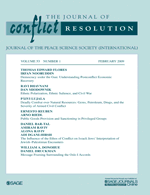Previous quantitative research on ethnic civil war relies on macro-level proxies in an attempt to specify the conditions under which ethnic minorities rebel. Going beyond an exclusive focus on minorities, the present study employs Geographic Information Systems (GIS) as a way to model ethnic center—periphery dyads that confront governments with excluded groups.
We construct and analyze a new dataset of geo-referenced politically relevant ethnic groups, covering the entire world during the period from 1951 through 2005. Our results show that the conflict probability of marginalized groups increases with the demographic power balance compared to the group(s) in power. Furthermore, the risk of conflict increases with the distance from the group to the capital, and the roughness of the terrain in the group's settlement area. We also find that while the results for demographic group strength hold for all ethnic civil wars, the geographic factors apply for territorial ethnic conflicts only.









